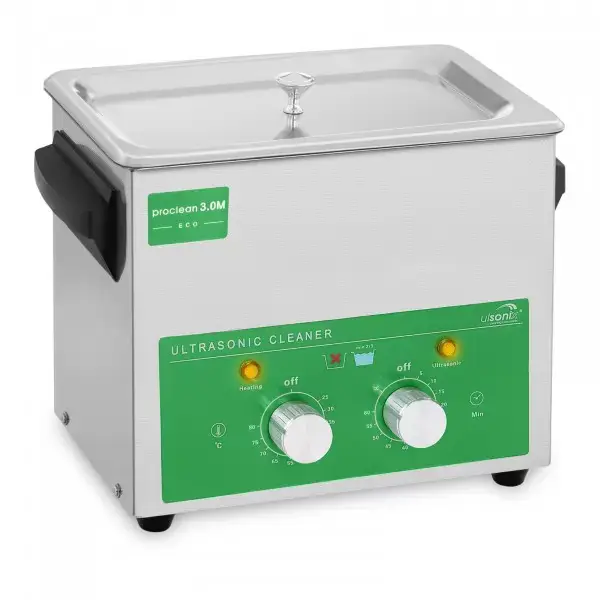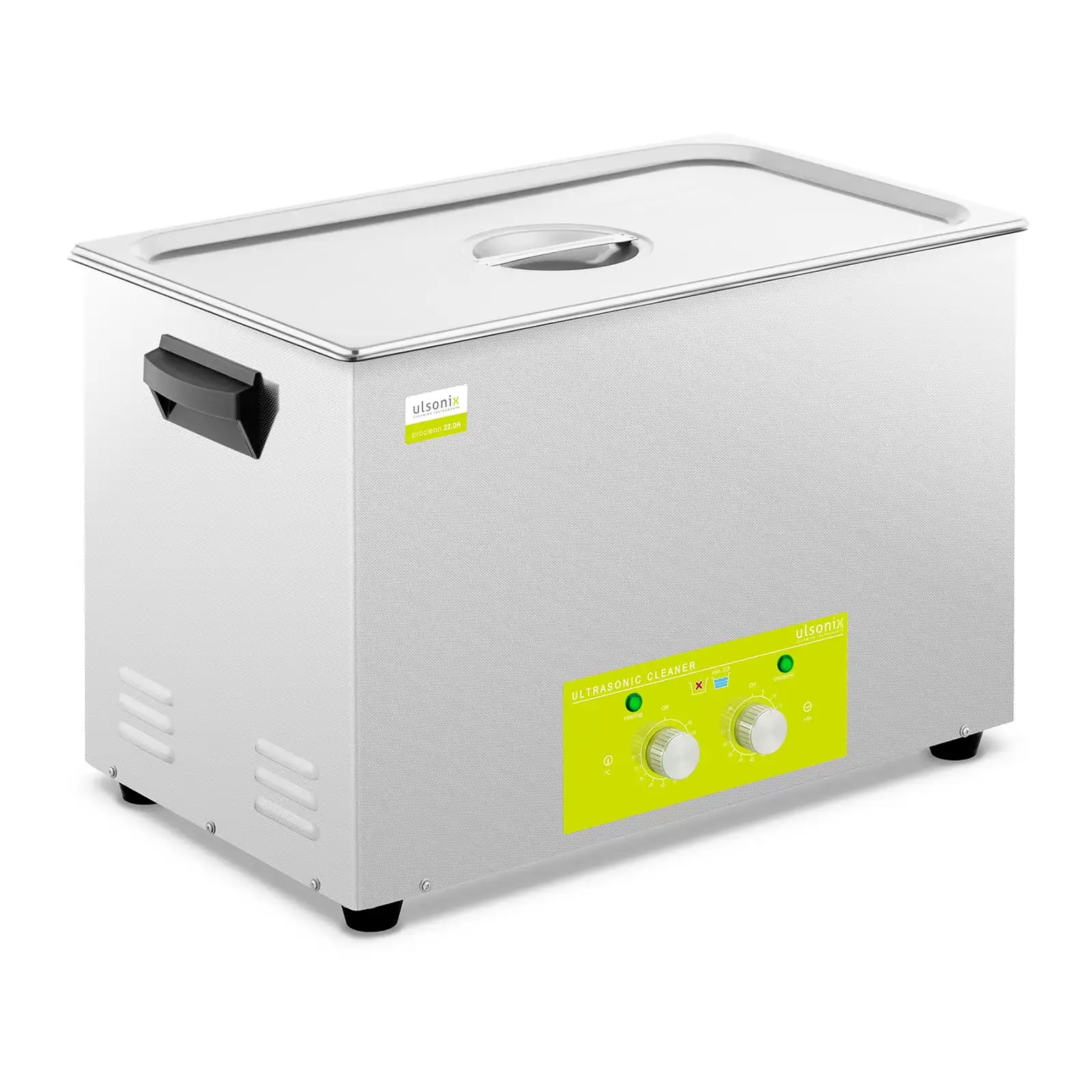In many industries, the frequent cleaning of components of various devices (e.g. electronic and mechanical), as well as jewellery, collector's coins, small tools and other various utensils is necessary. In this case, an ultrasonic cleaner is one of the most effective methods. Ultrasounds quickly and precisely remove dirt, even from hard-to-reach places. They also help fight allergies. In the case of particularly dirty items or items with extensive decorations, it is worth enhancing the cleaning effect. In such situations you will also need the appropriate cleaning fluids, which improve the cleaning effect and extend the life of the cleaning device.

In many industries, the frequent cleaning of components of various devices (e.g. electronic and mechanical), as well as jewellery, collector’s coins, small tools and other various utensils is necessary. In this case, an ultrasonic cleaner is one of the most effective methods. Ultrasounds quickly and precisely remove dirt, even from hard-to-reach places. They also help fight allergies. In the case of particularly dirty items or items with extensive decorations, it is worth enhancing the cleaning effect. In such situations you will also need the appropriate cleaning fluids, which improve the cleaning effect and extend the life of the cleaning device.
What should you use with your ultrasonic cleaner?
In the case of cleaning fluid for your ultrasonic cleaner, first of all make sure you use the right type of water. The first thing you need to do to enhance the cleaning performance of an ultrasonic cleaner is use deionised water, which is a natural solvent. It is recommended due to its lack of mineral salts and other impurities. It is also more reactive than ordinary water, and does not leave stains on washed items. If you cannot find any then you could also use distilled water, which is also of a high purity, or at least boiled water. However, the high frequency waves and water alone are sometimes not enough. In order to guarantee a fully satisfactory cleaning effect, an ultrasonic cleaner should be used (usually in the form of a concentrate for dilution with water). This will help get rid of traces of vegetable fats, car lubricants or mineral dirt.
Many shops are full of various products intended for cleaning different types of dirt. Among the wide range of products, you can also find products intended specifically for use in ultrasonic cleaners. Before choosing which product to buy, it is worth getting to know its chemical composition, properties and intended use in order to properly clean your items and make sure it is safe for your equipment. Before deciding to buy ultrasonic cleaning fluid, it’s good to know what it actually contains.
What does ultrasonic cleaning fluid contain?
Ultrasonic cleaning fluid usually has a relatively simple chemical composition. Before choosing the right product, however, you should bear in minde which items it will be used on. What works in cosmetology may not work with old coins. Effective cleaning is often determined by the proper selection of products for a specific material. Below is a list of the substances most often found in professional ultrasonic cleaning fluids available on the market.
- Non-ionic surfactants (tensides) – these are the primary ingredient in many cleaning fluids and account for about 90% of total surfactant production. They have a very high degreasing potential (compared to other types of surfactants), with a concentration usually <5%. They are good for removing: vegetable and animal fats, mineral and synthetic oils, as well as car lubricants. They are also not sensitive to hard water. Ultrasonic cleaning with a fluid containing non-ionic surfactants is a very good way to effectively clean e.g. a car carburettor.
- Anionic surfactants have a milder effect than non-ionic surfactants, so they are commonly used in cosmetics (including for babies). They are not very effective when it comes to removing greasy dirt and are sensitive to hard water. However, they successfully eliminate organic impurities, e.g. sweat residues and dead skin cells.
- EDTA is a chemical compound that increases the durability of the fluid and prevents changes in colour and consistency of the finished product. These properties make it widely used in cosmetics. It is commonly used to clean silver coins.
- A corrosion inhibitor slows down the process of corrosion This substance creates a layer on the surface of the cleaned metal, which protects it against damage. Another advantage is that the inhibitor protects not only the cleaned elements, but also the ultrasonic cleaner itself. This ingredient is especially recommended for cleaning jewellery with components made of base metals (e.g. nickel and copper). It should be found in fluids for ultrasonic cleaners used for jewellery.
- Ammonia is a compound of nitrogen and hydrogen with a wide range of applications. Its cleaning qualities are used to remove various types of dirt (e.g. grease in electric ovens, upholstery and carpet stains, soap residue on sanitary facilities) and caring for jewellery. Cleaning with the addition of ammonia is especially recommended for silver, which is the precious metal most susceptible to dirt . Products intended for use with jewellery should also remove remains of polishing pastes.
It is important that the fluid does not contain hydroxides that can damage soft metal objects, e.g. copper and gold. Information about biodegradability should be available on the label. This is a legal requirement.
| Ultrasonic cleaner for small objects | Ultrasonic cleaner for large objects and cleaning a large number of smaller items | |
| Ultrasonic cleaner |  Ultrasonic Cleaner – 3 Litres – 80 W – Basic Eco |  Ultrasonic Cleaner – 22 litres – 360 W |
| Volume | 3 l | 22 l |
| Container dimensions | 23,8 x 13,8 x 10,0 cm | 50 x 30 x 15 cm |
| Dimensions (LxWxH) | 17,00 x 30,00 x 23,50 cm | 59,00 x 33,00 x 36,00 cm |
| Weight | 3,24 kg | 11,70 kg |
| Ultrasonic power | 80 W | 2 x 60 W |
| Ultrasound frequency | 40 kHz | 40 kHz |
| Heating capacity | 155 W | 470 W |
| Timer | 0-60 min | 0-60 min |
| Maximum heating temperature | 80°C | 80°C |
| Example of use | – Smaller medical equipment – Laboratory equipment – Jewellery – Eyeglasses and watches – Hairdressing accessories – Metal articles (coins, small parts of mechanisms, etc.) – Tableware – Aquarium accessories | – Small and large medical equipment – Small and large medical and laboratory equipment (instruments, cuvettes, dishes) – Mechanical components (engine parts covered with grease and dirt) – Jewellery, glasses and watches – Hairdressing accessories – Tattooing accessories – Diving equipment |
Homemade cleaning fluids and solutions
Ultrasonic cleaners are also popular for private use, and some users prefer homemade cleaning fluids. For a much lower cost they often provide similar effects as commercial products specially designed for this type of devices. They also work well in situations where you are in urgent need of cleaning fluid. A mixture of half water and half spirit vinegar with a few drops of washing up liquid is very popular among military memorabilia and coin collectors. Baking soda (due to its foaming properties) and wall cleaner work well as a cleaning agents.
-
Ultrasonic Cleaner – 28 litres – 480 W – Memory-Quick Eco
439.00 GBP389.00 GBP -
Ultrasonic Cleaner – 10 litres – 240 W 239.00 GBP
-
Ultrasonic Cleaner- 0,7 litres – Basic 75.00 GBP
-
Ultrasonic Cleaner – 6 litres – degas – sweep – pulse
299.00 GBP269.00 GBP
Another frequently used ingredient is isopropanol (isopropyl alcohol). This widely available ingredient can be successfully used as a fluid for ultrasonic cleaners. It is safe on many materials thanks to being chemically neutral. It is mainly used in optics and electronics, and is very effective in cleaning and maintaining laser diodes in CD/DVD readers. You can use it without additionally diluting with water.
Before using any ultrasonic cleaner fluid
Before using any fluid in an ultrasonic cleaner, be sure to check the manufacturer’s recommendations on the label. If necessary, also read the operating instructions provided with ultrasonic cleaners to make sure the given product can be used. Bear in mind that using too weak a product for washing very dirty items will not guarantee the desired effect even after very thorough cleaning, while too strong a product on delicate items could damage them. Ultrasonic cleaning is an effective and generally safe method, however not all items can be treated in this way. For example pearl and coral jewellery, as well as gold/silver-plated jewellery, is not suitable.
By making sure beforehand, you can avoid potential damage or unsatisfactory results. Both the ultrasonic cleaner and the items cleaned in it will retain their colour, shape andproperties. You will also be satisfied with the final effect.






Share